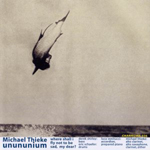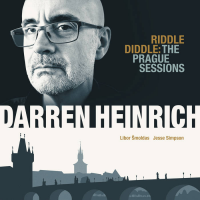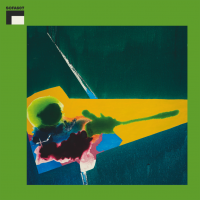Home » Jazz Articles » Multiple Reviews » Accordion to Jazz
Accordion to Jazz
 |  |  |  |
Ludovic Beier Quartet Chilltimes Le Chant du Monde 2007 | Klaus Paier & Gerald Preinfalk Saion Pao Records 2007 | Jurek Lamorski Quartet Lucky Membran Music 2007 | Michael Thieke Unununium Where Shall I Fly Not to be Sad, My Dear? Charhizma 2007 |
While modern jazz can enlist many timbres, the accordion is limited to a distinctive sound that everyone remembers. From distant memories of wedding bands, we recall the instrument in its stereotypical form: humble, harmonic and sometimes hilarious. The accordion can take on many different personalities, however, in the hands of creative artists who keep on searching.
Ludovic Beier brings us an instrumental voice similar to that of today's best jazz harmonicas on Chilltimes as he interprets this program of original music with his quartet. Sensual legato ballads and upbeat rhythmic romps bring the kind of character from his instrument that isn't usually associated with the accordion. Beier sings through both the accordion and the wind-driven accordina with a personal reflection that easily recalls the grace of harmonica players Toots Thielemans or Hendrik Meurkins. Beier, who's not yet 30, brings a fresh voice to modern jazz; however, his approach comes steeped deeply in the traditional sounds that have made today's music what it is. Along with pianist Christophe Cravero, bassist Diego Imbert and drummer Franck Agulhon, the accordionist strides right with an emphatic notice. As guitarist Angelo Debarre joins the quartet for "Guanabara Bay , the mood shifts to one of swing, recalling a great time for jazz in France: the era of Django Reinhardt. This one piece differs greatly from the rest of the album through its swing, but maintains a resolve for pure lyricism nevertheless. Vincent Youmans' "More Than You Know brings out the best from Beier's romantic side, while faster romps such as "Brooklyn Heights lay out the animated drive of his quartet in no uncertain terms.
The modern mainstream duo of Klaus Paier and Gerald Preinfalk for Saion retain the accordion's stereotypical sound while dressing up their aesthetic with bass clarinet, clarinet and soprano saxophone. Together, their duets become classic suites that deliver all kinds of scenery. It's all original music; however, much of what they create has been borne from the worlds of early jazz or classical music. Preinfalk brings the pure tone of each of his three woodwind instruments into focus clearly, parading around the slower accordion like a peacock ready for courtship. His is a classical tone with virtuosic technique. Paier's instrument, on the other hand, brings reedy eddies to the proceedings that recall centuries-old folk music association. Old meets new in this animated set that provides musical landscapes from Scotland, Spain, Austria, Norway, France, Israel and Argentina. "Klapperkiste wails with power on bass clarinet for the session's high point, while "Fango goes outside with soprano saxophone for a reckless affair.
Jurek Lamorski's quartet on Lucky features his accordion in a lyrical role along with the "singing guitar of Roland Cabezas, bassist Omar Rodriguez Calvo and percussionist Pablo Escayola. Sensual congas and pure, acoustic strings give the quartet a distinctive sound that complements the leader's accordion and recalls the work of masters such as Hermeto Pascoal and Astor Piazzolla. The ten selections, all Lamorski originals, vary the feel through blues, tango, ballads and relaxed adventure. The accordion flows with a character typical of the instrument; however, the artist and his musical partners ensure that the disc contains no dull moments. Lamorski's longest pieces — the title track, "For Cheops and "Polish Blues — stand out as session highpoints, affording more time for the quartet to dig in. He adds humor on the blazing-fast "Stupid Waltz , which lends an exciting moment to the music. With Lucky, Lamorski's quartet delivers a lovely session that everyone can enjoy.
As multi-instrumentalist Michael Thieke leads his quartet on Where Shall I Fly Not to be Sad, My Dear? in a program of originals, the scene shifts to cool jazz and leading-edge creative gestures. The leader plays alto saxophone, clarinet and alto clarinet and zither; with him on this adventurous album are bassist Derek Shirley, drummer Eric Schaefer and accordionist Luca Venitucci (who also plays prepared piano). Venitucci's accordion colors with snippets of sound delivered in brief bursts, while Thieke balances with equal and opposite actions. The session includes quite a bit of empty space where minor nuances fall into place casually. Founded several years ago with this May 2004 recording, Thieke's quartet reaches out for the mechanical in what they perceive. Most of the CD follows an unyielding path where bits of music are tossed out with unmetered punctuation that flows in uneven streams. Clarinet, accordion, bass and drums put their muscles together in a tight pattern that brings anxious tension, wide-open spaces and forceful statements through improvised music. Along the way, a taste of 'jazz' surfaces here and there for a few brief moments.
Tracks and Personnel
Chilltimes
Tracks: Chilltimes; Boarding First Class; Fall Memories; Brooklyn Heights; More Than You Know; Embarcadero West; No Valse; Guanabara Bay; Absenthe; Waltz for Richard; Playing with Idols; Loreley.
Personnel: Ludovic Beier: accordion, accordina; Christophe Cravero: piano; Diego Imbert: acoustic bass; Franck Agulhon: drums; Angelo Debarre: guitar (8).
Saion
Tracks: Saion; Rosenwald; Elisa; Schotti Beam Me Up; Klapperkiste; Just Like H.P.; Waltz for "G ; Elegie på Norsk; Libeingridi; Fango; Prelude; Prelude.
Personnel: Klaus Paier: accordion; Gerald Preinfalk: soprano saxophone, clarinet, bass clarinet.
Lucky
Tracks: Lucky; Tango a la Bango; Polish Blues; Infight; Tosiek's Waltz; Caucasian Express; For Cheops; Stupid Waltz; City Blues; Latin Farewell.
Personnel: Jurek Lamorski: accordion; Omar Rodriguez Calvo: double bass; Roland Cabezas: guitar; Pablo Escayola: percussion.
Where Shall I Fly Not to be Sad, My Dear?
Tracks: If I Think, Again, Of This Place; Fünf Treppen; Portnoy; Der Idiot; Nach Aussen Gewölbte Mönche; Mmm; Der Verfolger; Element 110; Einen Käfer Werfen.
Personnel: Derek Shirley: double bass; Eric Schaefer: drums; Luca Venitucci: accordion, prepared piano; Michael Thieke: alto clarinet, alto saxophone, clarinet, zither.
Tags
PREVIOUS / NEXT
Support All About Jazz
 All About Jazz has been a pillar of jazz since 1995, championing it as an art form and, more importantly, supporting the musicians who make it. Our enduring commitment has made "AAJ" one of the most culturally important websites of its kind, read by hundreds of thousands of fans, musicians and industry figures every month.
All About Jazz has been a pillar of jazz since 1995, championing it as an art form and, more importantly, supporting the musicians who make it. Our enduring commitment has made "AAJ" one of the most culturally important websites of its kind, read by hundreds of thousands of fans, musicians and industry figures every month.


















